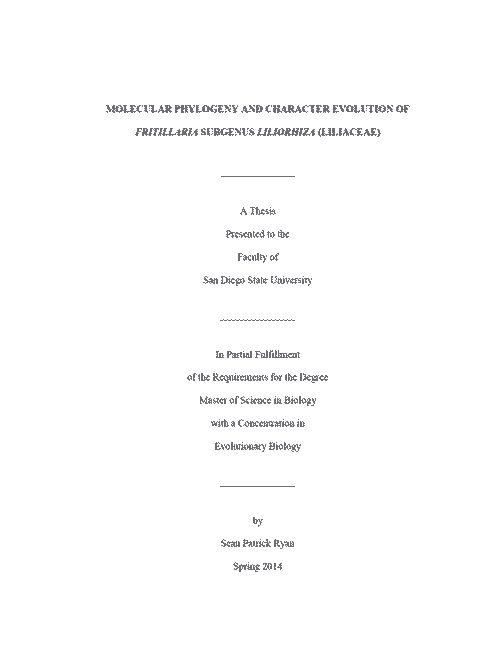NEWS 2014
Molecular Phylogeny and Character Evolution of Fritillaria Subgenus Liliorhiza (Liliaceae)
Sean Patrick RYAN
Master of Science in Biology with a Concentration in Evolutionary Biology
San Diego State University, San Diego CA, USA
Abstract
Fritillaria (Liliaceae) is a group of approximately 130 species of perennial geophytes distributed in the temperate northern hemisphere. The 20-25 North American species in the genus, along with a few species in east Asia, have been taxonomically separated into subgenus Liliorhiza based mainly on their bulb morphology. The taxonomy of this subgenus is confusing because of extensive synonymy and only half of the species have been studied in a phylogenetic context. Fifty seven samples of 25 taxa of Fritillaria subgenus Liliorhiza were sequenced for three gene regions, ITS, ETS, and the rpl16 intron region of the chloroplast genome. These data were combined with that of a previous phylogenetic study across the entire genus and used to assess phylogenetic relationships using maximum likelihood, Bayesian inference, and species tree estimation methods. Fritillaria subgenus Liliorhiza was found to be monophyletic, and it contains three clades corresponding to a previous morphology-based classification, with minor exceptions. Fritillaria affinis “tristulis”, a taxon currently considered illegitimate by recent taxonomists, was determined to be phylogenetically distinct based on a seven base pair indel discovered in the rpl16 intron, and by a Bayes factor comparison of species delimitation hypotheses. Fritillaria “ritteri”, a putative new taxon, formed a strongly supported clade separate from all other species in all analyses and was also determined to be phylogenetically distinct based on Bayes factor comparisons of species delimitation hypotheses. Divergence dating estimates indicate that Fritillaria subgenus Liliorhiza diverged from the rest of the genus approximately 4.6 million years ago. Character evolution analyses indicate that: (1) whorled leaf arrangement is ancestral for the subgenus and has changed to alternate one to many times; (2) rice-grain bulblets are ancestral for the subgenus and have been subsequently lost in a single clade; and (3) style division is a highly labile trait with little phylogenetic signal.

